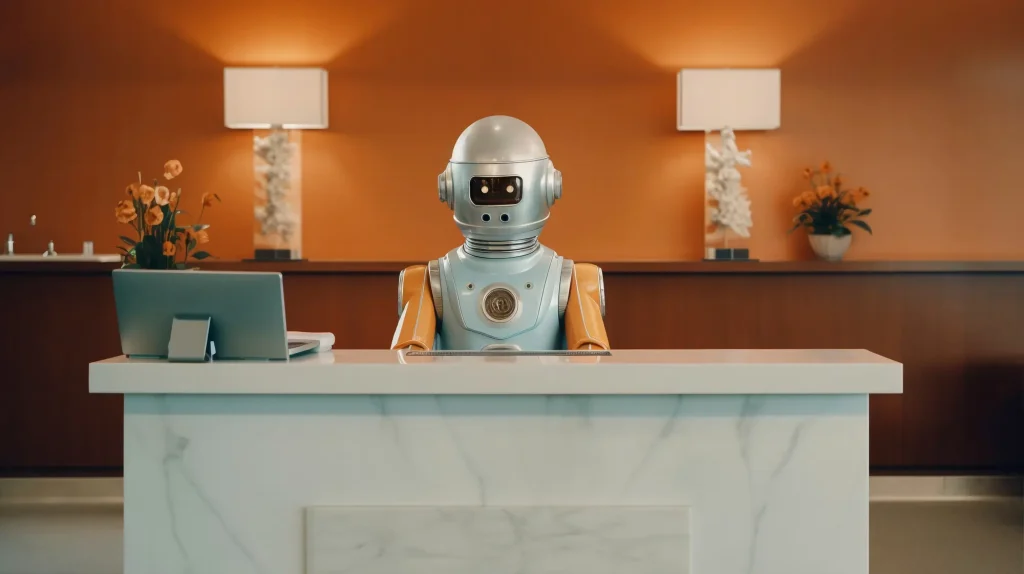Automation in the HR industry is not just a futuristic vision; it is a fast-evolving reality. As organisations strive for increased efficiency and precision, the introduction of robotics in HR processes is becoming more widespread.
Robotics enable streamlined operations by handling repetitive tasks, freeing up human resources to focus on more strategic objectives.
Why is HR turning to robots?
The decision to integrate robots within HR stems from the pressing need to enhance organisational efficiency and productivity. Robotics offer solutions that help in cost-cutting while scaling operations without proportionally increasing labour expenses.
By evaluating the pros and cons of robots, businesses can make informed decisions to optimise their HR functions. This strategic move allows HR departments to become transformational business partners that promote innovation and employee satisfaction while embracing technological advancements.
Efficiency and productivity

Robotics integration in HR significantly boosts efficiency and productivity by automating mundane tasks that typically consume a large portion of an HR manager’s time.
By utilising systems like those offered by MiHCM, HR departments can streamline traditional processes such as recruitment, performance management, and employee engagement.
This automation not only enhances the workflow but also liberates HR professionals from repetitive duties, allowing them to concentrate on strategic initiatives aimed at unlocking employee potential.
MiHCM products exemplify this by offering streamlined employee lifecycle management, ensuring tasks are completed swiftly.
Cost savings and return on investment
Implementing robotics in HR promises tangible cost savings. With automation, companies can experience a marked decrease in labour costs by optimising the workforce and minimising human errors, leading to fewer financial losses over time.
MiHCM solutions present enhanced HR analytics and data-driven insights which facilitate better decision-making processes. These efficiencies contribute to a reduction in operational costs while improving overall organisational productivity.
Enterprises find that investing in robotic systems results in a strong return on investment through scalable operations without the proportional increase in labour expenses, enabling HR departments to operate more dynamically and effectively.
- Streamlined HR work: Automation speeds up routine HR tasks, resulting in faster requests and approvals, contributing to enhanced team productivity.
- Reduced burden on HR staff: As robotics handle repetitive tasks, HR personnel experience greater job satisfaction due to more meaningful engagements.
The human touch vs. automation
With the integration of robotics in HR, a significant challenge that arises is the loss of the human touch, a key element that drives effective communication and personal empathy in employee interactions.
As pros and cons robots are evaluated, it becomes clear that while AI-driven systems excel at processing data, they struggle to replicate the emotional intelligence and creativity that humans naturally bring to the workplace. This inadequacy can lead to an impersonal work environment and potential disengagement among employees who value human interaction.
Skills gap and employee redundancy
Introducing robots into HR operations can inadvertently exacerbate the skills gap. As automation takes over routine tasks, certain roles may face redundancy, leaving a considerable portion of the workforce at risk.
It is crucial for businesses to address this issue by investing in employee training programmes aimed at developing skills that robots cannot replicate. This proactive approach can minimise job losses and prepare the existing workforce for new opportunities that emerge as technology evolves.
Ethical and privacy concerns
Adopting robotic solutions in HR also raises significant ethical and privacy concerns.
AI systems, if not properly monitored, can lead to biased decision-making, affecting recruitment and employee evaluations.
Additionally, these systems handle large volumes of sensitive employee data, which makes them susceptible to privacy breaches if adequate safeguards are not in place.
Organisations must implement strict policies and transparent communication to ensure that data is handled ethically and privacy is maintained.
- Loss of intuition: Machines lack the intuitiveness that humans possess, which can hinder cultural and emotional considerations in decision-making.
- Dependence on technology: Over-reliance on automated systems can lead to vulnerabilities, especially when technical issues arise.
- Bias in algorithms: Maintaining unbiased AI is challenging; biased data inputs may lead to unfair outcomes.
- Data security: Proper cybersecurity measures are imperative to protect employee information.
Mitigation through training
As organisations continue integrating automation in HR, addressing the skills gap emerges as a critical strategy.
Robotic solutions excel in automating routine HR tasks, but they often create a void when it comes to roles that require emotional intelligence and creativity. Thus, companies must invest in robust training and development programmes.
By reskilling employees, businesses can equip them with capabilities that automation cannot replicate, such as complex problem-solving and relationship building.
This approach not only minimises the risks associated with employee redundancy but also prepares the existing workforce for new opportunities that automation can create.
Balancing technology with human needs
Striking a balance between tech efficiency and the human touch is essential for a harmonious workplace environment.
While automation offers enhanced workflow and productivity, companies need to maintain a cultural core that values empathy and human interaction. Achieving this balance involves fostering an HR landscape where technology supports rather than replaces the human element.
Encouraging platforms for open dialogue, team collaboration, and personalised employee support can help maintain morale and employee engagement.
Moreover, transparent communication about the role of robotics in workflows ensures staff feels informed and valued in technological transitions.
- Comprehensive training: Establish ongoing education programmes focusing on non-automatable skills like emotional intelligence and creativity to bridge the skills gap.
- Transparent communication: Ensure employees understand the role of robotics and the intentions behind automation strategies to maintain trust.
- Technology-human integration: Leverage technology as a tool to enhance, rather than replace, critical human-centric services in HR.
- Feedback mechanisms: Create channels for employee feedback to continuously refine the balance of technology and human interaction.
Innovations in HR robotics
The future of HR automation is promising, with a wave of innovations set to redefine the role of robotics in human resources.
AI and machine learning are rapidly evolving, providing HR departments with powerful analytics and predictive capabilities. These technologies not only streamline HR processes but also offer enhanced insights into employee performance and potential.
Imagine systems that can autonomously manage and analyse employee engagement and satisfaction levels, enabling more proactive HR strategies. The adoption of cloud-based HR solutions, like MiHCM Enterprise and Lite, is expected to further drive efficiency, facilitating seamless integration of robotics into existing HR frameworks.
Looking ahead, trends such as increased personalisation in HR services are anticipated. With the power of AI, HR departments can offer tailored employee experiences, improving retention rates and overall satisfaction. Moreover, robotics in HR are expected to focus more on diversity and inclusion, leveraging advanced analytics to build balanced teams.
The long-term impact of robotics on the HR industry is significant, as it enables scalable, efficient operations. However, the balance between automation and human interaction remains vital, as employees still value the human touch in workplace communications.
As companies continue to embrace robotic integration, the strategic challenge will be to harness these innovations while maintaining a culture that values human interaction and creativity alongside technological advancement.
คำถามที่พบบ่อย
What tangible benefits does robotics offer HR teams?
Robotics enhances HR efficiency by automating routine tasks such as recruitment and performance management, offering more time for strategic initiatives. Automated systems like MiHCM Enterprise and Lite streamline operations, resulting in faster processing times and improved productivity.
What are the potential risks or downsides of integrating robots into HR?
The risks include a reduced human touch in employee interactions and ethical issues stemming from data handling and decision-making biases. Careful oversight and balanced integration can help mitigate these concerns, but it’s crucial to remain aware of the cons of robots.
How can companies mitigate the challenges associated with robotic automation?
Implementing robust training programmes addresses the skills gap, equipping employees with capabilities that robots can’t replicate. Companies should also balance technology with human needs by fostering environments where technology complements human interaction.
What balance should be struck between efficiency and the need for human interaction?
A balanced approach involves using robotics to handle repetitive tasks while ensuring employees engage in roles requiring personal interaction and creativity. Maintaining open communication about robotic roles in HR processes fosters trust and integration of technology with human-centric services.



